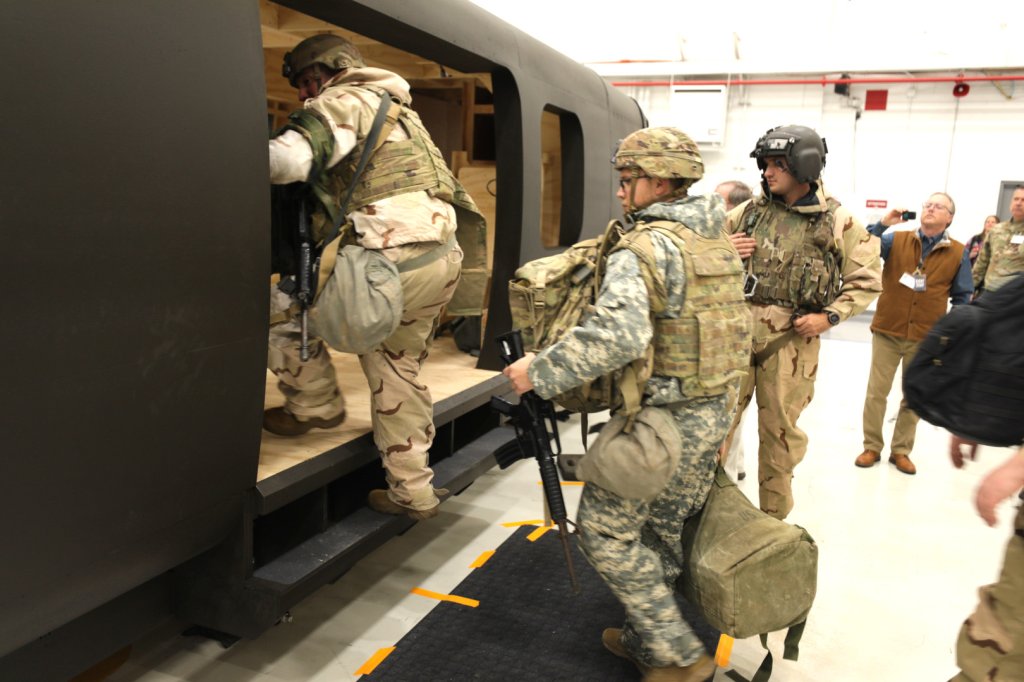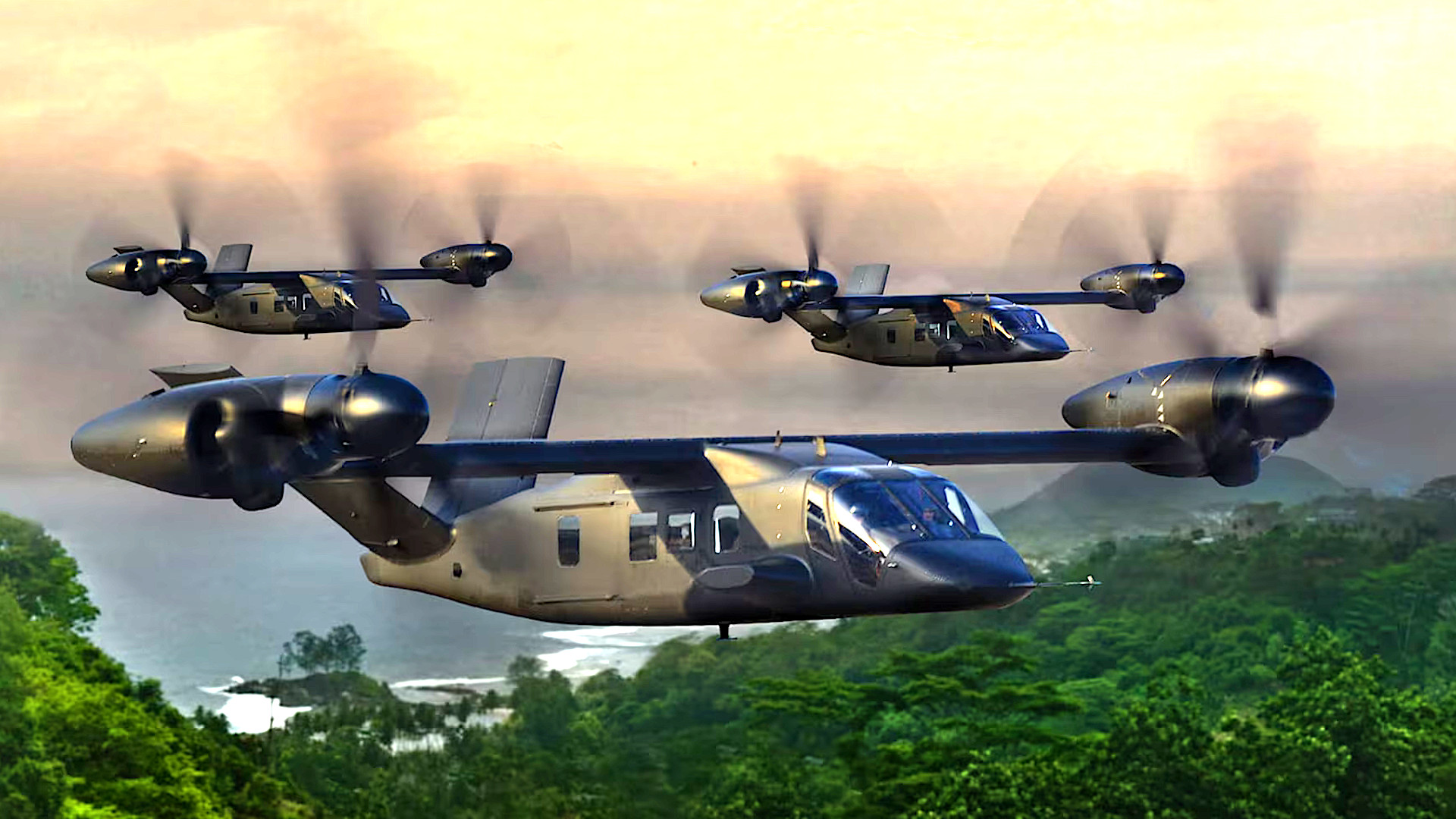The U.S. Army’s Future Long-Range Assault Aircraft (FLRAA) tiltrotor is shaping up to be significantly different from the V-280 Valor from which it is derived. Changes range from the design of the drive train to the fuselage layout to the arrangement of the seats inside the main cabin. The service’s goal is to have the initial FLRAA configuration largely nailed down by next year and development work is already informing exploration of how the new aircraft will be used operationally.
Army officials provided new details about the FLRAA program at a panel discussion today at the Association of the U.S. Army’s (AUSA) main annual conference in Washington, D.C. The service picked Bell and its V-280-based design as the winner of the FLRAA competition in 2022. A so-called Critical Design Review (CDR) is expected to occur next summer ahead of the planned delivery of the first of six FLRAA prototypes in 2026. The program schedule as it exists now sees low-rate initial production of the tiltrotors starting in 2028 and units beginning to use them operationally in 2030.

“To be very clear, and that’s why I very rarely use the term V-280 for FLRAA, the name of the aircraft will be different, the nomenclature will be different, the changes are significant,” Army Col. Jeffrey Poquette, the head of the program on the Army side, explained at AUSA. “The drive train has already been upsized to meet the purposes and intent for meeting our requirements.”
In terms of general performance, requirements the Army previously laid out publicly for FLRAA called for a design capable of hitting a top speed of at least 250 knots (285 miles per hour), and potentially up to 280 knots (320 miles per hour), and with an unrefueled combat radius of between 200 and 300 nautical miles. In testing to date, the experimental V-280, which has been flying since 2017, has reached a top speed of over 300 knots. The stated maximum speed and range of a typical current-generation Black Hawk under normal operating conditions is around 163 knots (187.5 miles per hour) and 268 nautical miles, respectively, according to Lockheed Martin, the parent company of the helicopter’s manufacturer Sikorsky.

The Army has also said in the past that it wants FLRAA to be able to carry 12 passengers, 4,000 pounds, or a mix of both, internally, as well as between 10,000 pounds and 13,100 pounds of additional cargo slung underneath the fuselage.
FLRAA is also expected to have the ability to carry munitions and other stores on stub wings just like Black Hawk variants and the exact configuration of sensors, antennas and other systems will need to be finalized, as well. A future special operations-focused subvariant is set to have other specialized features, too, including aerial refueling capability.

FLRAA will have other notable internal and external differences compared to the V-280.
“Something as simple as, will we have cockpit doors? The answer is no. But the Valor does,” Col. Poquette added. “We’ve already decided that the original [boarding] step [into the main cabin] was a little too narrow.”
“The things that matter to soldiers in the back are not drive trains or engines or rotors. What matters to them [are things like] is my seat comfortable? Does my ruck[sack] have to sit on my toes when I’m trying to get out? Am I going to trip over the guy in front of me?” the FLRAA program head continued. “So we spend a lot of time early trying to get the insight from the people that matter to us.”
Poquette highlighted experimentation utilizing a wooden FLRAA mock-up earlier this year at Wheeler Army Airfield in Hawaii earlier this year that involved personnel from the 25th Infantry Division as having provided key feedback.
“We spent a week out there with them [the members of the 25th Infantry Division], iterating on the two [internal] configurations we wanted to test. We started with one, the one actually that we thought we were going to choose with [regard to] seat configuration,” Poquette said. “We ran the soldiers through [drills]… without any combat gear, and then we added weapons, then we added body armor, then we added MOPP gear. We timed them.”
MOPP is the U.S. military’s suite of Mission Oriented Protective Posture protective gear, which includes gas masks and full body suits designed to help shield soldiers from chemical, biological, radiological, and nuclear hazards. MOPP gear is notoriously physically straining to wear, especially in extremely hot and humid environments.

“The people that do this kind of human systems science are technical experts, We measured every soldier with giant human-sized calipers,” Poquette continued. “We wanted to make sure we could take care of the fifth percentile soldier, the 95th percent percentile soldier.
“We ran it [the tests] at combat speed … even as the soldiers came out, they ran out, they went into the prone with their weapon, so it was as tactical as we could make it while getting the information that we need,” he added.”
“What we found out is that soldiers really liked the second configuration better,” the FLRAA program chief said. “Why did they like it? It was more comfortable, it was faster. They weren’t tripping over each other.”
Work on the internal configuration is not just limited to the arrangements of the passenger seats. There is the matter of where crew chiefs and other crew members will sit, as well as the positioning of weapons for self-defense. As seen below, the mock-ups the Army used in the tests in Hawaii had a crew-operated 7.62x51mm M240H machine gun mounted in a window on the side of the fuselage similar to the arrangement on the service’s existing Black Hawks.

Poquette said today that the configuration of the controls and other features in the FLRAA’s cockpit will also be different compared to how things are laid out on the V-280.
The Army has been conducting other similar testing with units beyond the 25th Infantry Division. Other experimentation to help lay the groundwork for the future fielding of the FLRAA is already well underway, as you can read more about here.
A so-called “virtual prototype” has been helping personnel get a more hands-on look at FLRAA even before the first real aircraft is built.
“A virtual prototype is similar to a simulator, to the average person it is a simulator, but it’s a little more fidelity than that,” according to Col. Poquette. “It really involves using the software that is going to be in the aircraft, coupling that with a model, or what we call a dynamics model, of how the aircraft flies and how it reacts to conditions and inputs.”
As can be seen in the picture below from the testing involving the mock-up earlier this in Hawaii, the Army has also been using augmented reality to give personnel a more in-depth experience so they can provide better feedback.

All of the initial FLRAA user testing and experimentation is particularly important given that the FLRAA is set to be the first-ever operational tiltrotor aircraft in the U.S. Army’s inventory and is expected to be a major transformational moment in its history. This will require the service’s pilots, especially, to learn entirely new skills sets and concepts of operations.
“How do I do an air assault with an aircraft that’s going nearly 300 knots? That’s something that Army aviators have never done before… as far as I know. It’s a different mindset,” Poquette explained. “We are helicopter pilots. … it’s [FLRAA] only a helicopter for like takeoff and land. That’s the whole point.”
“The Marine Corps does this. The Air Force Special Operations [Command] does. So we spend a lot of time with them on the program,” he continued. “I know there is a plan to familiarize Army rotary pilots [with tiltrotors]. We have the V-22, the V-22 is a tiltrotor. So I’ve already started meeting Army aviators who have experience in the V-22. I just hired an experimental test pilot who is qualified in the V-22. So we’re starting to build up the familiarity with a technology that the Army is just not really using.”

Bell, together with Boeing, developed the V-22 Osprey, which continues to be a controversial aircraft with a complicated track record. This was underscored by a fatal crash last year that led to virtually all of those aircraft being grounded for some three months. Work is still underway to address the root causes of that mishap and get Marine, Navy, and Air Force V-22 fleets back to their prior operational tempos. The V-280 and the FLRAA derived from it are clean-sheet Bell developments that differ greatly from the Osprey, as The War Zone has explored in detail before.
The Army has also previously said that it is already looking toward future FLRAA variants with new and improved capabilities. The service has long touted its key demand that FLRAA use a modular open-architecture approach as making it easier to integrate new systems and functionality onto the aircraft in the future, something that officials at AUSA reiterated today.
High-fidelity modeling and other digital engineering tools are also being actively employed now to help refine the baseline FLRAA design. The U.S. military continues to put heavy emphasis on digital engineering, especially in helping to avoid potentially costly issues down the road, despite growing internal and external assessments that the value of these techniques has at least been over-hyped.
“One of the things I try to impress upon people is budgets are tight. FLRAA is expensive. It’s the largest program in Army history,” Col. Poquette stressed today. “We can’t afford to make a big mistake. … we can’t afford to build the wrong thing. We can’t build four or eight prototypes that miss the mark on the thing that’s important to the Army.”

As of this year, the estimated total development cost for FLRAA is approximately $652 million, according to the Government Accountability Office. It could ultimately cost the Army around $70 billion to also acquire as many as 2,000 of the tiltrotors and sustain them across decades of expected service life. Tiltotor aircraft development, in general, has historically involved significant risk and FLRAA’s ongoing development comes as expected future battlefield realities also continue to evolve.
If all goes according to plan now, the Army will have largely finalized all the changes to its future FLRAA tilt-rotors from the V-280 design by the middle of next year, a key step forward toward getting the transformational aircraft into production and operational service.
Contact the author: joe@twz.com
